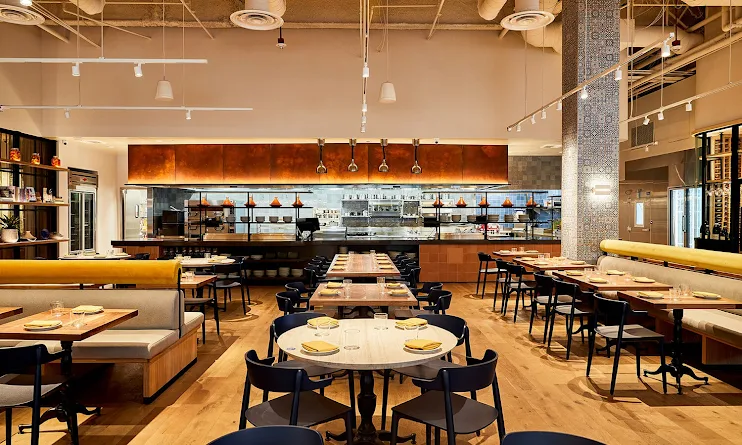From Dream to Delicious Reality: How To Open A Successfull Restuarant ?
 |
| Image creator: Lucianna McIntosh, Copyright: Lucianna McIntosh, Source: calliesd.com |
Opening a restaurant can be an incredibly rewarding venture. You get to share your passion for food, create a welcoming atmosphere, and be part of your community. But the road from dream to delicious reality is paved with important considerations. This guide will equip you with the knowledge you need to navigate the key factors that contribute to a successful restaurant.
Concept is King: Identifying Your Niche
Every successful restaurant starts with a strong concept. This is your unique selling proposition, the essence that will differentiate you from the competition. Here are some questions to guide you:
- What type of cuisine will you offer? Will it be a specific regional cuisine like Italian or Thai, or a broader concept like gastropub or farm-to-table? Consider your own culinary strengths and interests, but also market research to identify potential gaps.
- What kind of dining experience will you create? Fine dining, casual, family-friendly, or quick service? Think about the overall ambiance you want to cultivate, from the music and décor to the service style.
- Who is your target market? Understanding your ideal customer is crucial. Are you targeting young professionals, families, or health-conscious diners? Knowing their preferences will inform everything from menu pricing to marketing strategies.
Building a Solid Foundation: The Business Plan
With a clear concept in mind, it's time to translate your vision into a concrete plan. A well-written business plan is essential for securing funding, keeping you focused, and navigating challenges. Here are some key elements to include:
- Executive Summary: A concise overview of your restaurant concept, target market, and financial projections.
- Market Analysis: Research your competition, identify any gaps in the market, and analyze demographic trends in your chosen location.
- Management Team: Outline the experience and qualifications of yourself and any key team members.
- Marketing Strategy: Detail your plan for attracting customers, including social media presence, advertising strategies, and loyalty programs.
- Financial Projections: Create detailed forecasts for revenue, expenses, and profitability. Include startup costs, equipment needs, and ongoing operational expenses.
Location, Location, Location: Choosing the Right Spot
The saying holds true – location can make or break your restaurant. Here are some factors to consider:
- Foot Traffic: Is the area frequented by your target market? Is there good visibility from the street?
- Accessibility: Is there ample parking available? Is the location easily accessible by public transportation?
- Competition: Research nearby restaurants and identify how yours will differentiate itself.
- Rent and Lease Agreements: Negotiate a fair lease agreement that considers build-out costs, renovations required, and future growth potential.
 |
| Crowdy areas are surely will bring more customers in your restuarant. Image source: image6.cdn.seaart.me |
Funding Your Dream: Securing the Capital
Opening a restaurant can be a significant financial investment. Here are some funding options to explore:
- Personal Savings and Investment: Bootstrapping your venture is a viable option, but ensure you have enough capital to cover startup costs and operational expenses until profitability is achieved.
- Loans: Explore small business loans from banks or government agencies. Be prepared to present a compelling business plan to secure funding.
- Investors: Seeking angel investors or venture capitalists can provide a larger pool of capital, but be prepared to relinquish some control of your business.
Legal Matters: Permits and Licenses
Operating a restaurant requires obtaining various permits and licenses to comply with health and safety regulations. The specific requirements may vary depending on your location, so consult with your local authorities. Some common permits include:
- Business License: A general business license is required to operate in most jurisdictions.
- Food Service Permit: This permit ensures compliance with food safety regulations.
- Liquor License (if applicable): If you plan to serve alcoholic beverages, you will need a separate liquor license.
Building Your Dream Team: Hiring the Right Staff
Your staff is the backbone of your restaurant. Here are some tips for building a strong team:
- Hire for Passion and Train for Skills: Look for individuals who are passionate about food and service, and provide them with the necessary training to excel in their roles.
- Create a Positive Work Environment: Offer competitive wages, benefits, and opportunities for growth to retain top talent.
- Invest in Training: Provide comprehensive training on food preparation, customer service, and restaurant operations.
Crafting a Menu that Sells: Flavor and Profitability
Your menu is a crucial marketing tool. Here are some key considerations:
- Match your menu to your concept: Ensure the dishes offered align with your overall restaurant theme and target market.
- Costing and Pricing: Analyze food costs, labor costs, and overhead expenses to determine fair prices that will generate a healthy profit margin.
- Variety and Balance: Offer a variety of dishes to cater to different preferences, but avoid overwhelming customers with too many choices.
- Seasonality and Sourcing: Consider incorporating seasonal ingredients to create fresh, exciting dishes. Explore local sourcing to support your community and potentially reduce costs.
- Front-of-House Design: Create a welcoming atmosphere for your guests. Consider the seating arrangement, lighting, and overall décor.
Designing the Perfect Space: Functionality and Ambiance
The layout and design of your restaurant should be both functional and inviting. Here are some key aspects:
- Back-of-House Design: Ensure the kitchen is efficient and well-equipped for smooth operation. Plan the layout for optimal workflow, considering equipment placement and storage areas.
- Health and Safety: Adhere to all safety regulations regarding kitchen equipment, ventilation, and proper food storage.
 |
| Images like this can be used inside your restuarant or as an ads in streets to encourage your customers desires, specially hungry one. Image creator: zeljkosantrac, source: tastingtable |
- Develop a Strong Brand Identity: Create a logo, website, and social media presence that reflects your restaurant's concept and personality.
Marketing and Promotion: Reaching Your Audience
In today's digital age, a strong marketing strategy is essential. Here are some ways to reach your target market:
- Utilize Social Media Platforms: Engage with your audience on platforms like Instagram and Facebook to showcase your dishes, promote events, and interact with customers.
- Online Reviews and Reputation Management: Encourage satisfied customers to leave positive reviews online, and address any negative feedback promptly and professionally.
- Public Relations and Media Outreach: Connect with local media outlets to generate positive press coverage.
 |
| KFC ads on bus stop near school near to Littleover, Derby, England, ads on streets attract people in cars. source geograph.org.uk |
- Hire Friendly and Attentive Staff: Train your staff to be knowledgeable about the menu, anticipate customer needs, and provide a warm and welcoming experience.
Customer Service is King: Creating a Memorable Experience
Excellent customer service is what keeps guests coming back for more. Here's how to prioritize it:
- Go the Extra Mile: Small gestures like offering complimentary bread or a post-meal drink can make a big difference.
- Embrace Guest Feedback: Actively solicit feedback from your customers through surveys or comment cards. Use their input to improve your menu, service, or overall ambiance.
- Stay Informed About Industry Trends: Keep up-to-date with the latest culinary trends, customer preferences, and technological advancements.
The Importance of Adaptability: Embracing Change
The restaurant industry is dynamic and ever-evolving. Here are some ways to stay ahead of the curve:
- Embrace Technology: Explore online ordering systems, digital menus, and loyalty programs to enhance the customer experience.
- Continuously Improve: Regularly assess your performance, identify areas for improvement, and be willing to adapt your menu, marketing strategies, or operations based on market feedback.
The cost of opening a restaurant can vary dramatically depending on several factors, but we can provide a general range and some breakdowns to help you estimate. Here's a ballpark figure:
- Total Cost: The total cost to open a restaurant can range anywhere from $175,000 to $750,000 or even over $2 million for high-end establishments.
This broad range highlights the importance of careful planning and cost control. Let's break down some of the major cost contributors:
- Rent and Lease: This can be a significant ongoing expense. Depending on location, size, and build-out needs, expect to spend anywhere from $3,000 to $20,000 per month on rent.
- Construction and Remodeling: Costs can vary greatly depending on the extent of renovations required. Expect a range of $5,000 to $100,000 or more for basic improvements.
- Furniture, Fixtures & Equipment (FF&E): Tables, chairs, décor, kitchen equipment – this category can range from $50,000 to $200,000 depending on the quality and quantity of items needed.
- Permits and Licenses: Fees can vary by location, but $5,000 to $10,000 is a reasonable estimate for obtaining the necessary permits and licenses to operate.
- Inventory and Supplies: Initial inventory of food and beverage supplies, as well as cleaning supplies and other necessities, could cost $10,000 to $25,000.
- Marketing and Promotion: Getting the word out is crucial. Allocate $5,000 to $20,000 for initial marketing efforts, with ongoing costs depending on your chosen strategies.
Ongoing Operational Costs:
- Food Cost: This is typically the highest ongoing expense, typically ranging from 25% to 35% of your revenue.
- Labor Cost: Staff salaries and wages can account for another 20% to 30% of your revenue.
- Utilities: Electricity, gas, water, and waste disposal can add up to 5% to 10% of your revenue.
Remember, these are just estimates. The actual costs for your restaurant will depend on your specific concept, location, and chosen level of service. It's crucial to develop a detailed business plan that factors in all these expenses to determine the minimum amount of capital you'll need to get started and operate until profitability is achieved.
Opening a successful restaurant requires dedication, hard work, and a passion for hospitality. By following these steps, creating a strong foundation, and remaining adaptable, you can turn your culinary dream into a reality that thrives for years to come. Remember, the journey to a successful restaurant is a marathon, not a sprint. Be prepared to invest time, effort, and a genuine love for food and service into your venture.








